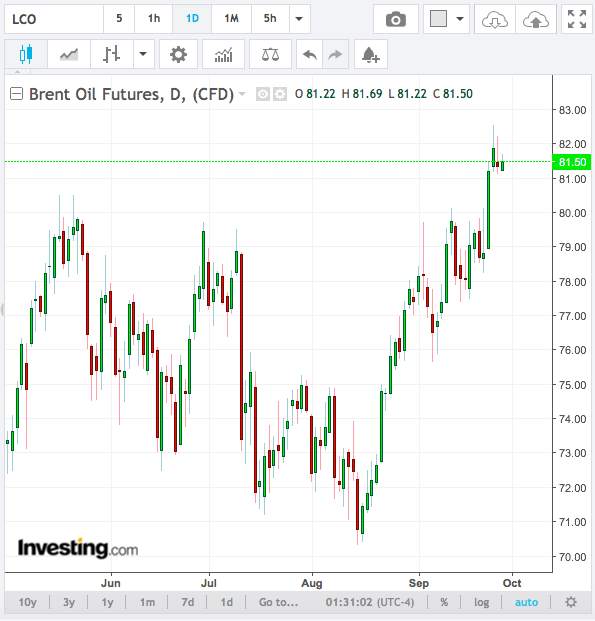Brent crude broke the symbolic $80 per barrel mark earlier this week and has spiked as high as $82 per barrel since then.

President Trump has been very vocal in blaming OPEC for rising oil prices, and he is partially correct. OPEC is not increasing production—or giving the appearance of increasing production—enough to lower prices.
Last Sunday, OPEC and its non-OPEC partners held their regularly scheduled Joint Ministerial Monitoring Committee Meeting (JMMC) at which they decided not to recommend any official increase in production to the OPEC and non-OPEC group at this time. This was the message oil traders heard, even though, it actually means the group will likely increase production. The group reiterated that it is still targeting compliance levels of 100%, but compliance has actually been 129%, so members with spare capacity will likely be increasing. Russia, Saudi Arabia and the UAE are the likely sources for production increases in October. Despite indications from these producers that more oil will be coming on the market next month, traders continued to push oil prices up above $80 per barrel.
The increase in Brent prices is clearly coming from speculation that the U.S. sanctions on Iran will remove a fairly significant amount of oil from the market (perhaps between 1 and 1.5 million barrels per day). The anxiety is that after the loss of so much Iranian oil from the market, any small crisis thereafter will cause a global shortage in oil.
These fears were stoked by market analysts from major trading houses speaking at a Singapore energy conference earlier this week. Several of them mentioned the possibility that oil prices could increase to the triple digits by the end of 2018. However, their predictions were based on extremely generous numbers, such as the removal of 2 million barrels per day of Iranian oil, and the concurrence of multiple risk scenarios. In other words, oil could hit $100 per barrel if Iran’s oil exports are reduced to zero and at least two or more of the following events occur in tandem: Iran closes the Strait of Hormuz to oil shipping (something it is likely incapable of doing for any duration), Venezuela’s oil exports dip to under 1 million barrels per day, a hurricane hits U.S. production in the Gulf of Mexico, or terrorism takes out additional Libyan and/or Nigerian production.
The prospect of $100 oil before 2019 was ludicrous enough for Goldman Sachs to counter the bullish forecasts issued by Mercuria Energy Group Ltd. and Trafigura Group and remind market watchers that such a large jump in prices is highly unlikely.
In fact, there are significant factors that continue to weigh on oil prices – particularly in the United States. Brent oil may be topping $80 per barrel, but the American benchmark, WTI, is at least $10 cheaper. Not only that, but the Canadian benchmark, WCS, is trading at an even more significant discount– as much as $40 per barrel off the price of WTI. A large part of these price differences are due to the fact that American and Canadian producers have to offer discounts to buyers because a lack of transportation infrastructure in North America has made moving the crude oil very expensive.
These transportation issues will certainly continue to impact North American crude oil prices at least through 2019. So while traders may continue to add a few dollars in speculative premiums to Brent through the end of the year, the potential for market conditions to push Brent into the triple digits is exceedingly unlikely. Meanwhile, North American crude will continue to have large discounts attached, making it all the more attractive on the global market.
